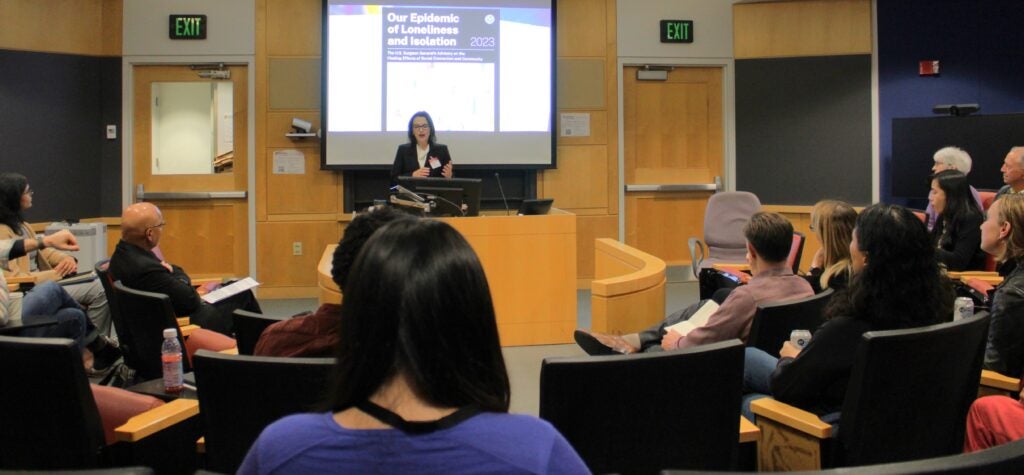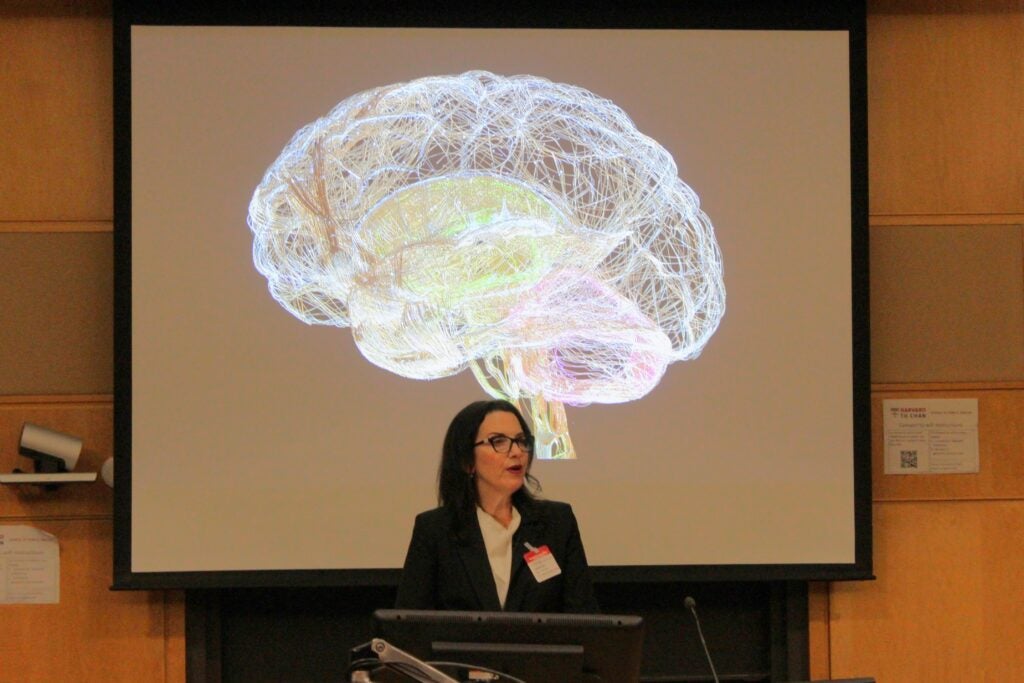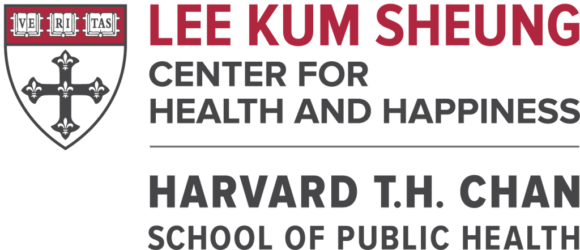On October 11th, the Center held the first event in our Loneliness and Well-being Seminar Series, “From Loneliness to Social Connection: Lessons from Research and a Global Pandemic”, with Dr. Julianne Holt-Lunstad. Dr. Holt-Lunstad is Professor of Psychology and Neuroscience and Director of the Social Connection and Health Lab at Brigham Young University. She is also the founding scientific chair and board member for the U.S. Foundation for Social Connection and the Global Initiative on Loneliness and Connection. Dr. Holt-Lunstad’s research has been seminal in the recognition of social isolation and loneliness as risk factors for early mortality. As the Lead Scientific Editor for the US Surgeon General’s Advisory and Framework for a National Strategy on Social Connection, her work also focuses on translating evidence into practice and policy.
Click here to watch a recording of the seminar.
The Problem: Loneliness and Social Isolation

“The public perception is that isolation and loneliness are a result of the pandemic,” stated Dr. Holt-Lunstad. “However, while social isolation was exacerbated by the pandemic, there is evidence going back decades of a decline in social capital. Many factors have contributed to this trend, including the growing use of social media.”
When discussing these matters, it is important to establish the official definitions of social isolation vs. loneliness.
Social Isolation: A state in which the individual lacks a sense of belonging socially, lacks engagement with others, has a minimal number of social contacts, and they are deficient in fulfilling and quality relationships.
Loneliness: The unpleasant subjective perception arising from the discrepancy between an individual’s desired and actual level of social connection.
“The Office of the Surgeon General’s Advisory on Loneliness and Social Isolation, my own work, and decades of interdisciplinary research are based on the premise that humans are fundamentally a social species,” explained Dr. Holt-Lunstad. “This social need is reflected in our neurobiology, which can shape our thinking, behavior, and functioning. Evidence points to dysregulation across multiple biological systems when various social needs are not met; and if sustained over time, this dysregulation can lead to the development of disease. Social environment, both in early life and adulthood, is one of the strongest predictors of morbidity and mortality risk across social species in nature—including humans.”
Negative Effects of Social Isolation:
- Physical health: Increased risk for heart attack, stroke, and type 2 diabetes
- Mental and Behavioral Health: Increased risk for depression, anxiety, addiction, and suicide
- Cognitive Health: Increased risk for dementia and Alzheimer’s
In 2015, Dr. Holt-Lunstad and others conducted a study which gathered all available global data at the time—including over 3.4 million participants—to examine the association between loneliness, social isolation, and mortality risk. The study found that among initially healthy people tracked over time, those who experienced social deficits were more likely to die earlier, regardless of the cause of death. Loneliness is associated with increased risk for earlier death by 26%, social isolation by 29%, and living alone by 32%.
Dr. Holt-Lunstad pointed out that social isolation and loneliness even influence economic outcomes. “Social isolation among older adults is associated with $6.7 billion annual Medicare spending,” she explained. “However, the economic burden of loneliness is likely much larger, given it has also been linked to greater workplace absenteeism, lower productivity, and lower quality of work.”
The Solution: Social Connection
 Studies show that on average, people who have strong social connections are happier, healthier, and live longer than those who don’t. Dr. Holt-Lunstad and others conducted a meta-analysis of 148 studies examining the protective effect of being socially connected, and found that social connection increases odds of survival by 50%.
Studies show that on average, people who have strong social connections are happier, healthier, and live longer than those who don’t. Dr. Holt-Lunstad and others conducted a meta-analysis of 148 studies examining the protective effect of being socially connected, and found that social connection increases odds of survival by 50%.
“The benefits of social connection extend beyond individuals to communities to society as a whole,” stated Dr. Holt-Lunstad. “These benefits range from population health to community safety, resilience, prosperity, and representative government; while lower levels of social connectedness suggest worse outcomes in each of these areas.”
“Several studies also document the importance of social connections in times of crisis,” continued Dr. Holt-Lunstad. “Whether it’s losing a job, a natural disaster such as flooding, fires, and earthquakes, a heatwave, pandemic, or war, the ability to mobilize resources via one’s social connections can be a matter of survival. Communities where people know one another are better prepared for, respond to, and recover more quickly from natural hazards than those with lower levels of social connection. As extreme weather patterns become more frequent, connected communities will be crucial to weathering these environmental crises.”
Dr. Holt-Lunstad went on to explain that while it’s a common conception that social isolation is a personal issue, that conception is incorrect. “A variety of factors outside of our control influence how socially connected we are, ranging from our health and financial situation, to the characteristics and behaviors of others in our household which may be a source of support or strain, to whether our neighborhoods are safe, walkable, and provide spaces to gather,” she stated. “Each of these can be the underlying cause of isolation or loneliness, but each can also be sources for solutions. To promote health, change is needed across the full scope of the society.”
While social connection is essential, it’s important to remember that it’s about quality, not quantity. Simply increasing social contact can backfire when you increase contact between individuals who don’t get along. “The US crisis line has 1.3 million texts, and the #1 reason for these texts is relationship conflict and distress, before suicide and isolation and loneliness,” she stated. “We can’t dismiss the importance of the quality of relationships to well-being; but it’s a factor that isn’t often measured.”
What Can Be Done?

In order to go beyond an individualistic or health sector perspective and develop a whole of society approach, Dr. Holt-Lunstad and her colleagues developed the “SOCIAL Framework”, or “Systemic Framework Of Cross-sector Integration and Action across the Lifespan”. It begins by centering the individuals and communities the policy seeks to help. Then the level of impact, sector of society, and cross-cutting themes are considered. Dr. Holt-Lunstad hopes that this framework will help policymakers to “systematically identify, test, and evaluate potential solutions that can accelerate progress in the promotion of social connection.”
“However, while formal programs and policies can be impactful, the informal practices of everyday life—the norms and culture of how we engage one another—significantly influence social connection,” stated Dr. Holt-Lunstad. “A culture of connection rests on core values of kindness, respect, service, and commitment to one another.”
In order to test the effects of an intervention to promote social connection, Dr. Holt-Lunstad and colleagues designed a multi-country randomized controlled trial with thousands of participants, where they randomly assigned half to a Kind Challenge and the others as a control group. The group that received the Kind Challenge were asked to do small acts of kindness for their neighbors at least once a week for a month. This could be whatever they felt comfortable with, such as checking in on a neighbor to see how they were doing, or something for the larger community such as picking up trash.
“The results were striking,” said Dr. Holt-Lunstad. “Acts of kindness significantly reduced loneliness, stress, and conflict with neighbors. Of course, the Kind Challenge is just one approach and multiple approaches are needed—including systemic changes in our communities.” However, this study does provide an example of a simple and effective intervention.
“Although this is not a new issue, the pandemic brought increased awareness and urgency to the importance of our social connection,” concluded Dr. Holt-Lunstad. “It highlighted the need to apply the most rigorous science available to address real world problems, and the need to communicate this effectively to the public. This is a critical opportunity to catalyze this shared experience to coordinate and accelerate efforts to promote social connection in our society.”
Q&A with Dr. Julianne Holt-Lunstad
After the seminar concluded, a group of Harvard scholars gathered for a lunch discussion with Dr. Holt-Lunstad and asked her the following questions.
Q: How does being an introvert vs. being an extravert influence an individual’s experience of loneliness and social isolation?
A: “What I usually get is ‘introverts don’t get lonely,’” remarked Dr. Holt-Lunstad. “During the pandemic, I heard ‘Introverts have been training for this their whole lives.’ However, introverts actually suffered more from the pandemic more, because they had less of a distance to fall.”
“We avoid a lot of things that are good for us, and socializing may be one of them,” continued Dr. Holt-Lunstad. “There’s a worrying trend recently of people choosing isolation. To encourage social connection, we should change the focus, and frame socializing as something that you give to others because it’s a good thing to do.”
Q: How is social media shaping the quality of relationships?
A: “It’s not that we don’t have enough evidence, it’s that we don’t have clear evidence. You can see both benefits and harms,” answered Dr. Holt-Lunstad. “This is my opinion, but I see social media like processed food. It’s a step removed from the real thing, and the real thing would be better. It’s more accessible and convenient, and sometimes it’s even more desirable. However, while you might enjoy it in the short term, is it nourishing in the long term?” She left the question open, concluding “Whatever hypotheses I have might be wrong. I don’t see the long-term studies happening that would provide an answer.”
Q: How can people promote social connection in their own lives?
A: Dr. Holt-Lunstad replied that it’s important to be actively engaged in your community, in order to feel a sense of belonging and purpose and build social capital.
Additionally, “Being more socially engaged exposes us to people with different views, perspectives, and backgrounds. That’s very important when we’re increasingly politically polarized,” stated Dr. Holt-Lunstad. “When you start to get to know people from different backgrounds, you can repair some of that social fabric that has been fraying.”
Dr. Holt-Lunstad recommended that people should start by reaching out to the people in their lives who they care about. “There’s research that shows providing support can have even more of an effect than receiving support,” she explained. “There’s a negative-reinforcing downward spiral of loneliness, but there’s also a positive-reinforcing upward spiral from doing things like reaching out to express gratitude and support.”
Resources
- Office of the Surgeon General’s Advisory on Loneliness and Social Isolation
- National Academies of Sciences, Engineering, and Medicine 2020 report
- Social Isolation, Loneliness & Living Alone
- Social Relationships
- Evidence for Social Connection as a Public Health Priority
- Social Connection as a Social Determinant of Health
- Why Social Connection is relevant to health
- Review of meta-analyses on the link between social connection and health

You must be logged in to post a comment.